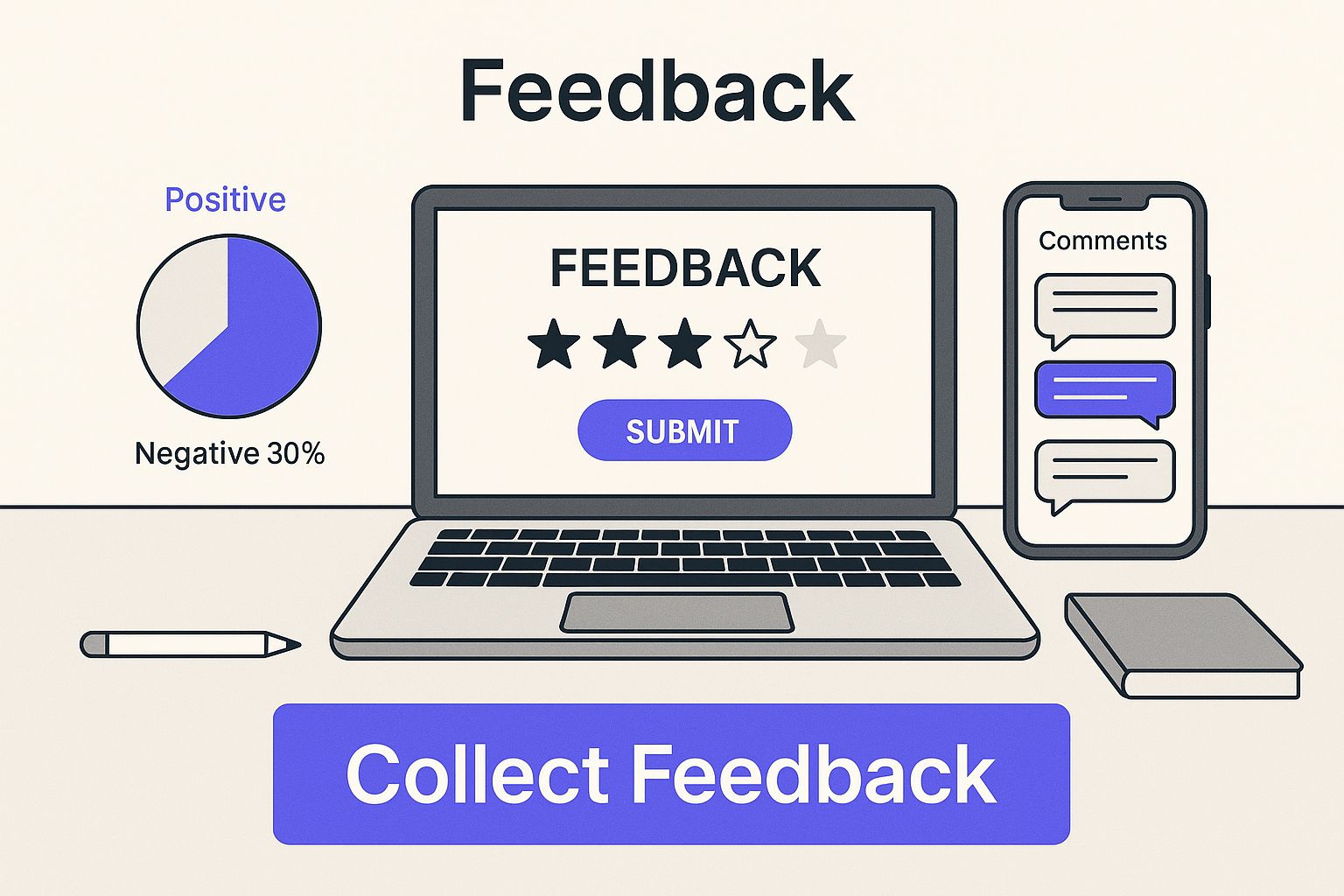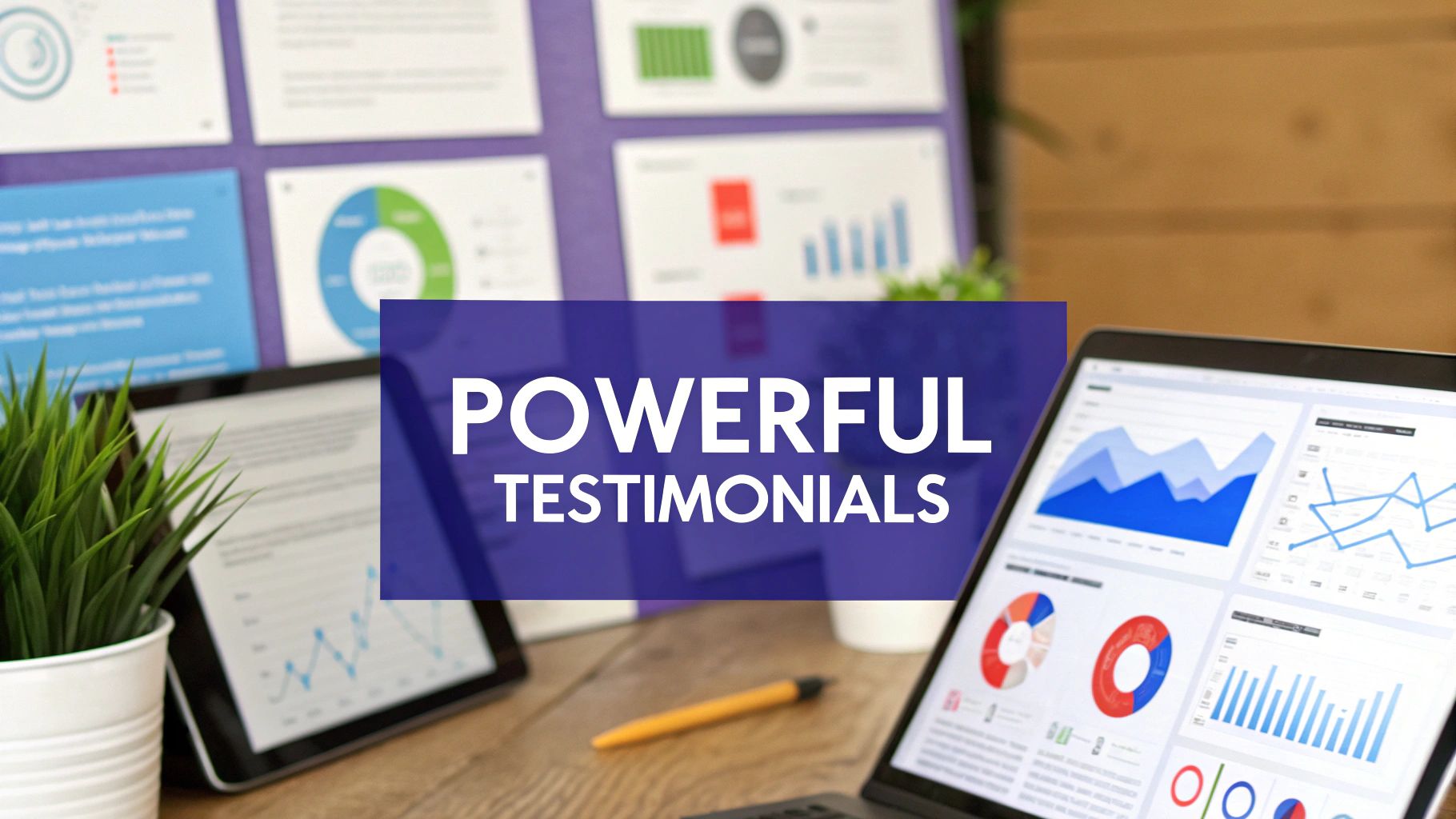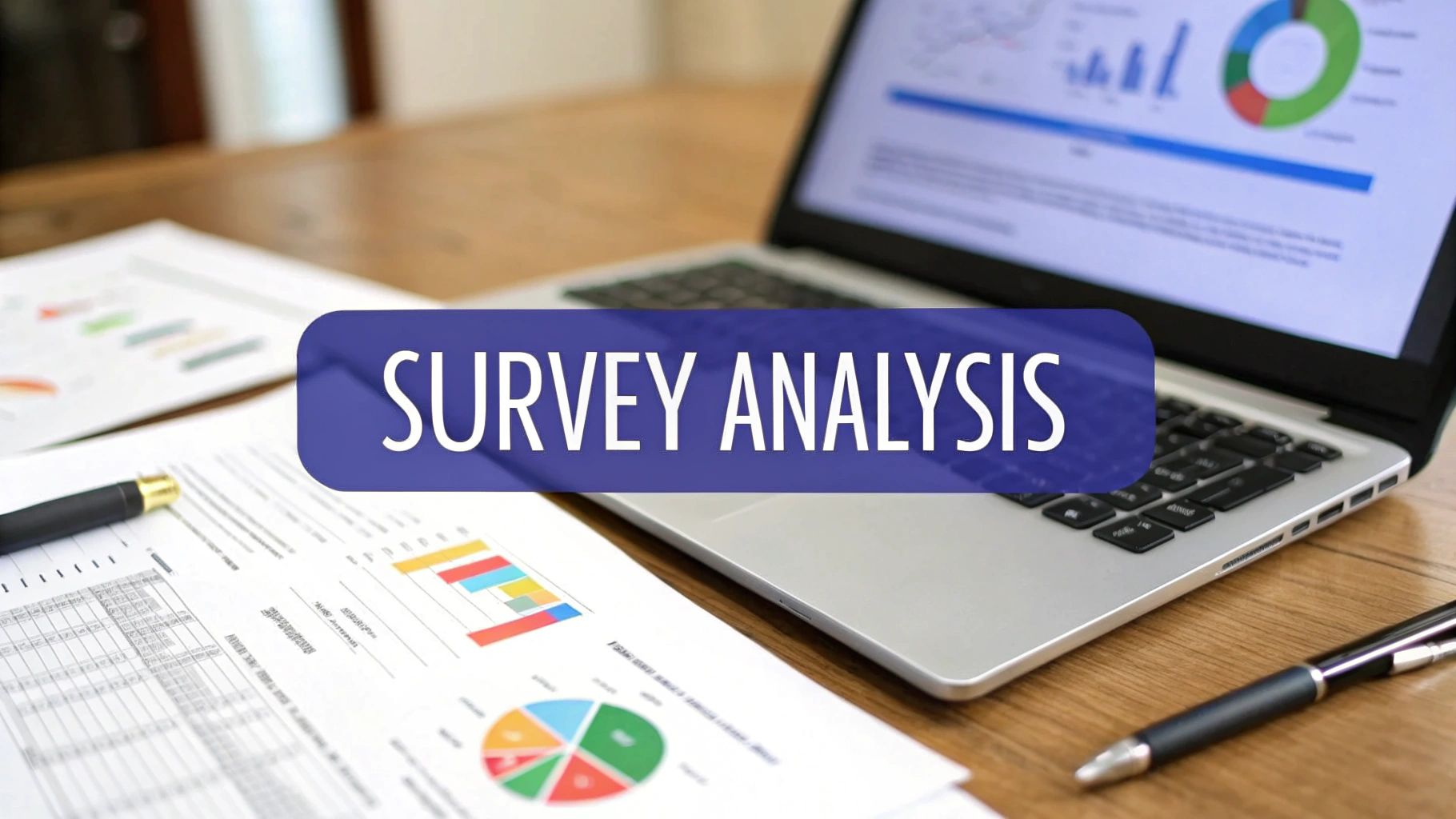What Is the Voice of the Customer Explained
Curious about what is the voice of the customer? This guide explains VoC, why it's a vital tool for your business, and how to use it for real growth.

The Voice of the Customer, or VoC, is a term for a simple idea: listening to what your customers are saying, figuring out what it means, and then doing something about it. It’s the process of capturing all their expectations, preferences, and frustrations to make your business better.
This goes beyond just collecting reviews. It’s about building a structured program to turn customer opinions from random noise into your most valuable asset for growth.
What Is the Voice of the Customer Really About?

Think about a chef trying to run the best restaurant in town. They could guess what diners want, or they could pay attention. A great chef listens to everything: the dishes people scrape clean, the offhand comments to the waiter, the online reviews, and even the direct suggestions they get. All that feedback helps them tweak recipes, overhaul the menu, and perfect the entire dining experience.
A Voice of the Customer (VoC) program does the same thing for your business. It is a structured method for listening to customers across every single channel where they might be talking about you.
The Core Goal of VoC
The whole point is to get an unfiltered, honest look at what your customers are experiencing and what they expect from you. This is about more than damage control when things go wrong. It’s about proactively figuring out what your customers genuinely need and value.
This feedback becomes the foundation for making smarter decisions across the board, from product development to your marketing copy.
VoC is the process of gathering all customer feedback—the good, the bad, and the “meh”—and using it to make better business decisions. It’s about shifting from guesswork to data-backed action.
This concept isn't new, but it has grown into a massive industry focused on helping businesses sharpen their strategies. A lot of this growth comes from new technologies, especially in sectors like banking where AI-powered chatbots are improving customer engagement. The bottom line is that customer-centric strategies are no longer optional if you want to stay competitive. You can find out more about the VoC market and its growth here.
Before we go further, let’s quickly break down what a VoC program actually includes. It is a complete system, not just a series of surveys.
Core Components of a VoC Program
A solid VoC program needs all these pieces working together. Collecting feedback without analyzing it is a waste, and analyzing it without taking action is pointless.
Why Ignoring Customer Feedback Is a Risk
Businesses without a formal VoC program are flying blind. You might be missing huge opportunities for improvement or, worse, be completely unaware of a major problem until it’s too late.
Ignoring what your customers are telling you can lead to serious pain points:
- Higher Churn: Unhappy customers who feel like they’re shouting into the void are the first ones to leave.
- Wasted Resources: You end up building products or features that nobody actually asked for.
- Ineffective Marketing: Your messaging completely misses the mark because it doesn't speak to your audience's real needs.
A VoC program takes all those scattered customer comments and turns them into an organized stream of insights. It helps you spot trends, prioritize the right issues, and act on feedback before small headaches turn into massive problems. It transforms customer opinions from background noise into your single most powerful tool for sustainable growth.
Why a VoC Program Drives Business Growth
Putting a Voice of the Customer (VoC) program in place is more than a nice-to-have for your support team. Think of it as a direct line to sustainable growth. When you stop guessing what customers want and start systematically listening, you gain a massive advantage. You can finally make informed decisions that actually move the needle.
A good VoC program is like an early warning system. It helps you flag unhappy customers and catch potential problems before they snowball into widespread churn. At the same time, it hands you the blueprint for building products and features people are genuinely excited to use, and more importantly, pay for.
Improve Customer Retention and Reduce Churn
Getting a new customer costs a lot more than keeping one you already have. A well-structured VoC program is one of the most effective tools you have for boosting retention. By consistently gathering feedback, you can spot at-risk customers and step in before they walk out the door.
For example, a SaaS company might notice a recurring theme in their cancellation surveys about a confusing feature. That is a gift, not just a complaint. It tells them exactly where to focus their efforts, whether that’s creating better tutorials or redesigning the feature altogether to plug a leaky hole in their revenue bucket.
In fact, companies that actively run VoC programs often spend 25% less on customer retention than those who don't. Why? Because they're solving problems proactively instead of scrambling to react after a customer has already decided to leave.
By listening to the reasons customers leave, you uncover the exact steps needed to convince others to stay. This feedback loop is a powerful engine for long-term customer loyalty.
And it's not all about the negative feedback. A strong program also helps you find what you're doing right. When you can pinpoint the features and experiences your most loyal customers rave about, you know exactly where to double down to keep them happy.
Fuel Product Innovation with Real Feedback
Guesswork is the most expensive mistake you can make in product development. Building features that nobody asked for is a huge drain on time, money, and morale. A VoC program strips away that uncertainty by putting real customer needs right at the heart of your product roadmap.
Gathering this feedback systematically helps you spot issues early and prioritize the fixes that will make the biggest impact on users. This alignment drives real product innovation. When you act on this data, you start meeting customer expectations before they even have to ask, which is a massive driver for loyalty and growth. You can explore more on why VoC is key for business growth on inmoment.com to see just how VoC data grows revenue.
Imagine multiple customers requesting an integration with a specific tool through feedback forms and support tickets. Suddenly, the product team isn’t just considering a new feature; they have clear, data-backed validation to prioritize it. This makes certain every bit of development effort goes toward creating value that customers have explicitly told you they want.
This direct line to your users' needs creates a powerful competitive edge. While your competitors are stuck in brainstorming meetings, you're building a product that's actively shaped by the people who use it every day. That leads to higher adoption, better satisfaction, and a much stickier product.
Create Marketing That Actually Connects
How do you describe your product? Now, how do your customers describe it? Oftentimes, there’s a major disconnect between the two. A VoC program gives your marketing team the exact language your customers use to talk about their problems and how your solution makes their lives better.
When you look into reviews, testimonials, and survey responses, you'll find powerful phrases and pain points that truly connect with your target audience. It's like getting a cheat sheet for your marketing copy.
Here’s how VoC makes your marketing instantly better:
- More Effective Ad Copy: Use your customers' own words in your ads to grab attention and build an immediate connection.
- Higher-Converting Landing Pages: Stop talking about features and start addressing the specific problems and desired outcomes you've pulled from their feedback.
- Stronger Brand Messaging: Shape your entire brand message around the value that your happiest customers keep highlighting.
This approach makes your marketing feel less like a sales pitch and more like a genuine conversation. It proves to potential customers that you truly know their world, which is the fastest way to build trust and drive conversions.
How to Collect VoC Data Effectively
To really get a handle on the Voice of the Customer, you need a solid game plan for collecting their feedback. This means more than sending out one big survey once a year. It's about creating a multi-channel listening strategy that meets your customers exactly where they are, whether they're actively trying to give you feedback or just chatting about their experience online.
The best approach mixes both direct and indirect methods. Direct methods are when you're proactively asking for feedback, while indirect methods involve tuning into conversations that are already happening. If you only rely on one, you're getting a skewed, incomplete picture of your customer's reality.
Using Direct Channels for Feedback
Direct feedback channels are your most straightforward path to gathering structured information. These are the methods where you're in the driver's seat, controlling the questions you ask and who you ask them to. They're perfect for getting clear answers to your most pressing questions.
Here are a few of the most common direct methods:
- Surveys: This is probably the most popular way to collect structured feedback. You can use them at different points in the customer journey, like after a purchase, following a support ticket, or even when a customer decides to cancel their subscription. Our guide on how to get customer feedback covers these strategies.
- Interviews: A one-on-one conversation with a customer can uncover incredibly rich, detailed insights. They take more time, but the depth of information you can pull from a single interview is often worth the effort.
- Feedback Forms: Simple, always-on feedback forms embedded on your website or inside your app give customers an easy outlet to share their thoughts whenever the mood strikes. This can be a fantastic source for unsolicited but highly valuable suggestions.
When it comes to getting qualitative insights, methods like asking strategic questions within your community can reveal customer perspectives. These open-ended conversations often bring pain points and hidden desires to the surface in a way a multiple-choice survey just can't.
Tapping into Indirect Feedback Sources
Indirect feedback is just as valuable, and sometimes more so, because it’s often more honest and unfiltered. This is the feedback customers give when they don't necessarily think you're listening. It requires you to put on your detective hat and piece together clues from all over the web.
This infographic shows how you can pull feedback from all sorts of digital touchpoints, from a feedback form on a laptop to social media comments on a phone.

The image captures the modern reality of VoC data collection, where feedback flows in from multiple platforms at the same time.
Common sources for indirect feedback include:
- Online Reviews: Websites like G2, Capterra, or even Google are absolute treasure troves of detailed customer opinions. Customers often leave long, specific feedback here about what they love and what they hate.
- Social Media Comments: Your social media channels are a real-time feed of customer sentiment. Keeping an eye on mentions, comments, and direct messages gives you an immediate pulse on how your brand is being perceived.
- Support Tickets: Your customer support conversations are a goldmine of VoC data. Reviewing support tickets can help you spot recurring product bugs, areas of confusion in your UI, and common feature requests.
By combining direct and indirect listening, you create a complete view of the customer experience. Surveys tell you what customers think, but reviews and support tickets often tell you why.
To help you decide which methods are right for you, here’s a quick breakdown of the most common approaches.
Comparison of VoC Data Collection Methods
Each method offers a different piece of the puzzle. The real power comes from combining them to get a well-rounded view.
Building a Multi-Channel Listening Strategy
Relying on a single source of feedback is a risky move. If you only use surveys, you're only hearing from the customers who are motivated enough to respond. If you only monitor social media, you might completely miss the quieter customers who are churning without saying a word.
A Gartner prediction states that by 2025, 60% of organizations with a VoC program will move beyond just surveys to include a much wider range of sources. This shift points to a clear trend: companies are learning that to get an accurate picture of the customer journey, they need to listen everywhere.
A strong listening strategy uses a mix of methods that play off each other's strengths. For instance, you might spot a recurring complaint in your online reviews (indirect) and then send out a targeted survey (direct) to dig deeper into that specific issue. This approach lets you validate your findings and gather more structured data to plan your next move. The key is to be present and attentive wherever your customers choose to share their voice.
Turning VoC Data Into Actionable Insights
So, you've collected a ton of customer feedback. That's a fantastic start, but data on its own is just raw material. The real work happens when you transform those scattered comments, survey scores, and support tickets into a clear plan of action.
This is where you connect the dots between what customers are telling you and what your business needs to do next. The goal is to sift through that mountain of feedback and pull out a handful of high-impact priorities. It’s all about finding the signal in the noise so you can confidently decide what to build, what to fix, and how to make the customer experience genuinely better.
From Raw Data to Clear Themes
The first step in making sense of it all is organization. Raw feedback is messy and unstructured. To see the bigger picture, you have to start grouping similar comments together. This process is often called thematic analysis.
Think of it like sorting laundry. You wouldn’t just throw everything, whites, colors, delicates, into one giant pile and hope for the best. You separate them into logical piles. You need to do the exact same thing with your customer feedback.
You’ll start to see common themes pop up, like:
- Product Bugs: Specific technical glitches that are driving people crazy.
- Feature Requests: New ideas and capabilities your customers are asking for.
- Pricing and Billing Concerns: Feedback on your pricing, plans, or the payment process.
- Usability Issues: Comments about the product being confusing or just plain hard to use.
- Positive Experiences: Notes about what customers absolutely love and what’s working well.
By categorizing the feedback, patterns emerge from the chaos. You might suddenly realize that 15% of all support tickets last month were about the same login bug. Just like that, you've found a high-priority fire to put out.
Analyzing Sentiment and Identifying Root Causes
Once you have your themes, it’s time to dig a little deeper. Two really powerful ways to do this are sentiment analysis and root cause analysis. These methods help you find not just what customers are saying, but how they feel and why they feel that way.
Sentiment analysis is all about figuring out the emotional tone behind the words. Is the feedback positive, negative, or neutral? This adds an important layer of context. A feature request from a super enthusiastic power user lands differently than a bug report from a customer who is clearly at their wit's end.
Root cause analysis pushes you to look past the surface-level complaint to find the real, underlying problem. A customer might complain about slow loading times, but the root cause might be an inefficient database query on your end, not their internet connection.
Fixing the root cause is what prevents the issue from happening over and over again. It’s the difference between patching a leak and replacing the faulty pipe. For a more structured approach, you can learn more about how to analyze survey data to uncover these deeper insights.
Prioritizing What Matters Most
Okay, so you've analyzed your data and now you have a long list of potential actions. The final, and most important, step is prioritization. You simply can't fix every bug and build every feature request at once. You need a system to decide what to tackle first.
A simple but effective way to prioritize is to look for patterns across all your different data sources. For instance, if a specific feature request comes up in your annual survey, pops up constantly in online reviews, and is a common topic in support tickets, that’s a massive signal. It tells you the demand is widespread and not just the opinion of a few loud customers.
Consider using a simple framework to rank each potential action. You could score each item based on three key things:
- Impact: How many customers does this actually affect?
- Urgency: How critical is this issue to the overall customer experience?
- Feasibility: How much time and effort will it take for your team to implement a solution?
This kind of structured approach helps you focus your limited resources on the changes that will deliver the most value to both your customers and your business. It turns the entire Voice of the Customer process from a simple listening exercise into a powerful engine for making smart, strategic decisions.
Putting VoC Insights to Work Across Your Business

So, you’ve collected a ton of customer feedback and turned it into clear, actionable insights. What now? The real value appears when that information breaks out of a spreadsheet and gets into the hands of the people who can use it.
A Voice of the Customer (VoC) program truly comes alive when its findings are shared across departments. It stops being just "data" and becomes a shared source of truth that gets the entire company focused on what the customer actually wants.
When product, marketing, and support teams are all working from the same customer playbook, the whole business starts moving in the right direction. It creates a unified experience for users and transforms a good company into a great one.
How Product Teams Can Use VoC Data
For product teams, VoC data is pure gold. It takes the guesswork out of building a better product, making sure that precious time and resources are spent on features that customers will actually use and love.
Think of feedback as a direct line into your users' biggest headaches and wishes. By reviewing feature requests, bug reports, and usability complaints, product managers can build a roadmap that’s based on real-world evidence, not just internal brainstorming sessions.
Let's say the team notices a recurring complaint in surveys about how clunky it is to export data. That single insight could spark several key actions:
- Prioritizing a new feature to allow for simple, one-click data exports.
- Improving the existing workflow by adding clearer instructions or helpful tooltips.
- Validating the demand for a more advanced, customizable reporting dashboard down the line.
This data-first approach makes sure every development cycle delivers real value. It turns the product roadmap from a list of nice ideas into a strategic response to what your customers are telling you they need.
How Marketing Teams Can Benefit from VoC
Marketers are constantly searching for the perfect words to connect with their audience. VoC data literally hands them the exact language customers use to talk about their problems and the value they get from your product. This is a total game-changer for creating messages that actually hit home.
Instead of talking about technical specs, marketers can highlight the benefits and outcomes that customers are already raving about in their feedback. This makes ad copy, landing pages, and email campaigns way more effective because they're speaking the customer's language. Mapping out the user journey with tools like customer experience mapping can also pinpoint those perfect moments where the right message will make all the difference.
When you use your customer's own language in your marketing, you build an instant connection. It shows you're not just selling a product; you get their challenges.
Imagine a marketing team discovers through reviews that customers love their software because it "saves them an hour every Monday morning." That specific, powerful phrase is so much more compelling than a generic claim like "our software improves productivity." Using that quote in an ad campaign could easily lead to a huge jump in conversions.
How Support Teams Can Leverage VoC Insights
Customer support teams are on the front lines, but they can be more than just reactive problem-solvers. VoC data helps them to become proactive, spotting and solving issues before they flood the support queue.
Analyzing support tickets helps teams identify common points of confusion or frustration. This insight is incredibly valuable for improving the overall customer experience and, in the long run, reducing the support team's workload. These insights aren't just for product development; they're valuable for improving core functions like enterprise customer service.
Here’s how VoC can supercharge a support team:
- Create Better Documentation: If tons of users are asking the same question, the support team can create a great knowledge base article or a short video tutorial to clear things up for everyone.
- Suggest Product Improvements: They can flag recurring technical bugs for the product team, armed with direct evidence and quotes from real customer conversations.
- Offer Proactive Help: By spotting trends, they can reach out to new customers who might be about to hit a common roadblock and offer a helping hand before they even have to ask.
The demand for these capabilities is exploding. The global VoC software market is projected to grow at a compound annual growth rate of 22.3%, as more companies use these tools to fine-tune their products and build loyalty. North America is leading the charge, but the Asia Pacific region is catching up fast thanks to rapid digital adoption. You can discover more insights about the VoC software market and its impressive growth.
Got Questions About VoC? We’ve Got Answers.
Even after you get the hang of what the Voice of the Customer is all about, a few common questions always seem to surface. They usually pop up right when businesses start trying to connect the theory to their day-to-day reality. This section cuts straight to the chase, answering the most frequent questions we hear about building and running a VoC program.
We'll clear up the confusion between everyday feedback and a formal VoC program, share some practical tips for small businesses on a tight budget, and show you how to tie your efforts back to real business results.
What Is the Difference Between VoC and Regular Customer Feedback?
At first glance, Voice of the Customer (VoC) and regular customer feedback can look like the same thing. And while every VoC program is built on customer feedback, not all feedback is part of a VoC program. The real difference comes down to two things: structure and intent.
Regular customer feedback is often something you collect passively or by chance. It might be a random comment on a social media post or an email that lands in your inbox out of the blue. This stuff is valuable, for sure, but it’s usually unstructured and isn't part of a bigger strategic plan.
A VoC program, on the other hand, is a deliberate, proactive system. It’s all about intentionally collecting, analyzing, and acting on feedback from multiple channels to make smarter business decisions. It’s the difference between occasionally overhearing what a customer says and actively listening to guide where your company is headed.
Think of it this way: a single drop of rain is feedback. A weather station that collects, measures, and forecasts based on rainfall patterns is a VoC program. One is a random event; the other is a strategic system.
How Can a Small Business Start a VoC Program with a Limited Budget?
You don’t need a massive budget to start a great VoC program. Small businesses can get an effective program off the ground with free or low-cost tools and a healthy dose of creativity. The goal is to be consistent and take action, not to buy fancy software.
Start by making the most of the tools you already have. The most important step is just creating a simple way to track what you’re hearing and look for recurring themes.
Here are a few low-budget ways to get started:
- Set up Google Alerts: Create alerts for your brand name, products, and even your main competitors. It’s a completely free way to keep an eye on online mentions and reviews.
- Use Free Survey Tools: Platforms like Google Forms or the free plans offered by many survey tools are perfect for sending out short, targeted surveys after a purchase or support chat.
- Monitor Social Media Manually: Make a habit of actively reading the comments, mentions, and direct messages on your social media accounts. This is a direct pipeline to your customers' thoughts.
- Read Online Reviews: Regularly check review sites that are relevant to your industry. This gives you raw, unfiltered feedback that’s incredibly useful.
Once the feedback starts rolling in, use a simple spreadsheet to log everything. Create columns for the source, the main theme (like a bug report or feature request), and any action you took. This simple habit is the foundation of a seriously powerful VoC program.
How Do You Measure the ROI of a Voice of the Customer Program?
Measuring the return on investment (ROI) of your VoC program is all about connecting the dots between your listening efforts and tangible business outcomes. You have to show how the insights you’re gathering are leading to better customer satisfaction, higher retention, and, ultimately, more revenue.
The trick is to link specific actions you took based on VoC data to measurable results. It’s not enough to say you "listened to feedback." You need to prove how that listening turned into a positive change for the business.
To calculate ROI, focus on tracking these key metrics before and after you implement changes driven by VoC insights:
- Customer Churn Rate: If insights help you fix a product issue that was causing complaints, track the drop in your churn rate. A lower churn rate has a direct, positive impact on your bottom line.
- Customer Lifetime Value (CLV): Happier, more loyal customers tend to stick around and spend more over time. Keep an eye on the CLV of customer groups who’ve benefited from VoC-driven improvements.
- Conversion Rates: Did you use language from customer feedback in your marketing? Measure the impact on conversion rates for your ads and landing pages. A 10% increase in conversions is a crystal-clear return.
- Net Promoter Score (NPS): While it's not a direct financial metric, an improving NPS is a powerful leading indicator of customer loyalty and future growth.
For example, let's say your VoC data uncovers a major point of frustration in your onboarding flow. You use that insight to create a new tutorial video. Afterwards, you can measure whether support tickets related to onboarding go down and if new user retention goes up. That link between action and outcome is exactly how you measure VoC ROI.
Ready to turn customer feedback into your biggest growth driver? With Surva.ai, you can build intelligent surveys and feedback flows that not only tell you what your customers are thinking but also help you take action in real-time. Start reducing churn and building a better product today by visiting https://www.surva.ai.


